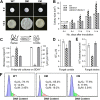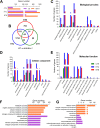BbWor1, a Regulator of Morphological Transition, Is Involved in Conidium-Hypha Switching, Blastospore Propagation, and Virulence in Beauveria bassiana
- PMID: 34319134
- PMCID: PMC8552717
- DOI: 10.1128/Spectrum.00203-21
BbWor1, a Regulator of Morphological Transition, Is Involved in Conidium-Hypha Switching, Blastospore Propagation, and Virulence in Beauveria bassiana
Abstract
Morphological transition is an important adaptive mechanism in the host invasion process. Wor1 is a conserved fungal regulatory protein that controls the phenotypic switching and pathogenicity of Candida albicans. By modulating growth conditions, we simulated three models of Beauveria bassiana morphological transitions, including CTH (conidia to hyphae), HTC (hyphae to conidia), and BTB (blastospore to blastospore). Disruption of BbWor1 (an ortholog of Wor1) resulted in a distinct reduction in the time required for conidial germination (CTH), a significant increase in hyphal growth, and a decrease in the yield of conidia (HTC), indicating that BbWor1 positively controls conidium production and negatively regulates hyphal growth in conidium-hypha switching. Moreover, ΔBbWor1 prominently decreased blastospore yield, shortened the G0/G1 phase, and prolonged the G2/M phase under the BTB model. Importantly, BbWor1 contributed to conidium-hypha switching and blastospore propagation via different genetic pathways, and yeast one-hybrid testing demonstrated the necessity of BbWor1 to control the transcription of an allergen-like protein gene (BBA_02580) and a conidial wall protein gene (BBA_09998). Moreover, the dramatically weakened virulence of ΔBbWor1 was examined by immersion and injection methods. Our findings indicate that BbWor1 is a vital participant in morphological transition and pathogenicity in entomopathogenic fungi. IMPORTANCE As a well-known entomopathogenic fungus, Beauveria bassiana has a complex life cycle and involves transformations among single-cell conidia, blastospores, and filamentous hyphae. This study provides new insight into the regulation of the fungal cell morphological transitions by simulating three models. Our research identified BbWor1 as a core transcription factor of morphological differentiation that positively regulates the production of conidia and blastospores but negatively regulates hyphal growth. More importantly, BbWor1 affects fungal pathogenicity and the global transcription profiles within three models of growth stage transformation. The present study lays a foundation for the exploration of the transition mechanism of entomopathogenic fungi and provides material for the morphological study of fungi.
Keywords: Beauveria bassiana; Wor1; blastospore; conidia; germination; morphological transition; virulence.
Figures




Similar articles
-
The Zinc Finger Transcription Factor BbCmr1 Regulates Conidium Maturation in Beauveria bassiana.Microbiol Spectr. 2022 Feb 23;10(1):e0206621. doi: 10.1128/spectrum.02066-21. Epub 2022 Feb 9. Microbiol Spectr. 2022. PMID: 35138172 Free PMC article.
-
The Tudor Domain-Containing Protein BbTdp1 Contributes to Fungal Cell Development, the Cell Cycle, Virulence, and Transcriptional Regulation in the Insect Pathogenic Fungus Beauveria bassiana.Microbiol Spectr. 2021 Sep 3;9(1):e0056421. doi: 10.1128/Spectrum.00564-21. Epub 2021 Aug 11. Microbiol Spectr. 2021. PMID: 34378960 Free PMC article.
-
Deciphering roles of nine hydrophobins (Hyd1A-F and Hyd2A-C) in the asexual and insect-pathogenic lifecycles of Beauveria bassiana.Microbiol Res. 2025 Mar;292:128029. doi: 10.1016/j.micres.2024.128029. Epub 2024 Dec 20. Microbiol Res. 2025. PMID: 39724799
-
Signaling Pathways Regulating Dimorphism in Medically Relevant Fungal Species.Pathogens. 2025 Apr 4;14(4):350. doi: 10.3390/pathogens14040350. Pathogens. 2025. PMID: 40333127 Free PMC article. Review.
-
Cell Biology of Hyphal Growth.Microbiol Spectr. 2017 Apr;5(2):10.1128/microbiolspec.funk-0034-2016. doi: 10.1128/microbiolspec.FUNK-0034-2016. Microbiol Spectr. 2017. PMID: 28429675 Free PMC article. Review.
Cited by
-
Inhibitory effects of a maleimide compound on the virulence factors of Candida albicans.Virulence. 2023 Dec;14(1):2230009. doi: 10.1080/21505594.2023.2230009. Virulence. 2023. PMID: 37367101 Free PMC article.
-
Transcriptomic atlas throughout Coccidioides development reveals key phase-enriched transcripts of this important fungal pathogen.PLoS Biol. 2025 Apr 15;23(4):e3003066. doi: 10.1371/journal.pbio.3003066. eCollection 2025 Apr. PLoS Biol. 2025. PMID: 40233121 Free PMC article.
-
Transcriptomic Analysis Reveals That Rho GTPases Regulate Trap Development and Lifestyle Transition of the Nematode-Trapping Fungus Arthrobotrys oligospora.Microbiol Spectr. 2022 Feb 23;10(1):e0175921. doi: 10.1128/spectrum.01759-21. Epub 2022 Jan 12. Microbiol Spectr. 2022. PMID: 35019695 Free PMC article.
-
Transcriptomic atlas of the morphologic development of the fungal pathogen Coccidioides reveals key phase-enriched transcripts.bioRxiv [Preprint]. 2024 Oct 14:2024.10.13.618122. doi: 10.1101/2024.10.13.618122. bioRxiv. 2024. Update in: PLoS Biol. 2025 Apr 15;23(4):e3003066. doi: 10.1371/journal.pbio.3003066. PMID: 39463982 Free PMC article. Updated. Preprint.
-
Absence of neutrophils impairs the host defense in murine footpad model of chromoblastomycosis.PLoS Negl Trop Dis. 2025 Apr 23;19(4):e0012986. doi: 10.1371/journal.pntd.0012986. eCollection 2025 Apr. PLoS Negl Trop Dis. 2025. PMID: 40267064 Free PMC article.
References
-
- He PH, Dong WX, Chu XL, Feng MG, Ying SH. 2016. The cellular proteome is affected by a gelsolin (BbGEL1) during morphological transitions in aerobic surface versus liquid growth in the entomopathogenic fungus Beauveria bassiana. Environ Microbiol 18:4153–4169. doi:10.1111/1462-2920.13500. - DOI - PubMed
Publication types
MeSH terms
Substances
LinkOut - more resources
Full Text Sources
Molecular Biology Databases
Research Materials

